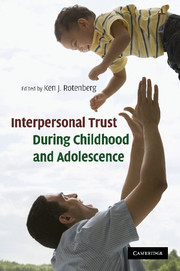Book contents
- Frontmatter
- Contents
- List of figures
- List of tables
- List of contributors
- Section I Conceptual foundations and issues
- 1 Introduction
- 2 The conceptualization of interpersonal trust: A basis, domain, and target framework
- 3 Neurobiology of interpersonal trust
- 4 Children's sense of trust in significant others: Genetic versus environmental contributions and buffer to life stressors
- Section II Childhood
- Section III Adolescence and early adulthood
- Index
- References
3 - Neurobiology of interpersonal trust
Published online by Cambridge University Press: 04 August 2010
- Frontmatter
- Contents
- List of figures
- List of tables
- List of contributors
- Section I Conceptual foundations and issues
- 1 Introduction
- 2 The conceptualization of interpersonal trust: A basis, domain, and target framework
- 3 Neurobiology of interpersonal trust
- 4 Children's sense of trust in significant others: Genetic versus environmental contributions and buffer to life stressors
- Section II Childhood
- Section III Adolescence and early adulthood
- Index
- References
Summary
The study of trust has a long and rich history in the field of human development (Erikson, 1963; Rotenberg, 2001). Over four decades ago, Erikson (1963) argued that the first experiences an infant has with his/her mother or primary caregiver are based on trust. According to Erikson, successful navigation of the infant through the trust versus mistrust stage of development is critical for the infant's future emotional and social functioning. Attachment theory further proposes that the quality of the early mother–infant interaction influences the infant's cognitions about future social relationships. Thus, a caregiver who is sensitive and responsive to his/her infant has a child who in turn develops a cognitive model of social relationships that include trustworthiness and dependability (Schore, 2001a, 2001b, 2005). In contrast, if a caregiver is insensitive to the needs of the infant and fails to respond to the infant's needs, or responds in an inappropriate manner, this will result in the infant developing a cognitive model of relationships as being unsafe and unreliable (Schore, 2001a, 2001b). Given these developmental trajectories, it is clear that the early mother–infant relationship plays a crucial role in the infant's development of trust towards the world.
- Type
- Chapter
- Information
- Interpersonal Trust during Childhood and Adolescence , pp. 28 - 55Publisher: Cambridge University PressPrint publication year: 2010
References
- 2
- Cited by



